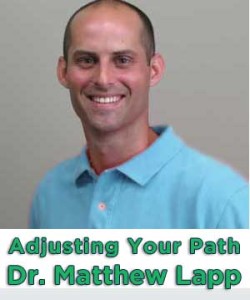While New Year’s Resolutions are nice, sometimes, you need a bigger plan
By Dr. Matthew Lapp, Columnist, The Times
 At this time of year, many people begin to contemplate their health. Some of us may even choose to make resolutions to lose weight, exercise more, or give up unhealthy habits. However, the truth is that only about 46% of people who actually make resolutions follow through with them.
At this time of year, many people begin to contemplate their health. Some of us may even choose to make resolutions to lose weight, exercise more, or give up unhealthy habits. However, the truth is that only about 46% of people who actually make resolutions follow through with them.
For the majority of people, resolutions are made and then forgotten. One of the most common reasons for this fact is that we often neglect to consider all of the aspects of our lives which contribute to create our unhealthy habits in the first place. Another common pitfall is the quest to find a “quick fix” for long-standing issues or concerns. Thus, thinking from a holistic viewpoint and working with a holistic coach or practitioner can not only shed light, but also help to create a sustainable strategy to achieve greater health and wellbeing in the future.
Theoretically, holism considers the universe as comprised of interacting, living, whole organisms that express more than the sum of their parts. This basic concept is sometimes overlooked in the definition of holistic health, yet it plays an integral role in understanding what holistic care aims to achieve within the context of the practitioner-patient (client) relationship. When this relationship is successfully applied, bountiful outcomes and a state of harmonious living can unfold.
A truly comprehensive system of care that encompasses the physical, emotional, social, economic, environmental and spiritual needs of the individual will consider each of these factors when addressing unique wellness needs. In addition, the actual relationship between the practitioner and the client should foster a sense of enhancement of the experience.
Since wellness is an active state of being that exists on a limitless continuum, it is up to us to claim ownership of that state, regardless of our life circumstances. So, if our goal is to achieve balance and nurture healing in such a multi-dimensional approach, it is wise to seek practitioners that share these perspectives, and study and advocate behaviors that promote health. Together, the practitioner and client can explore the variables that affect one’s perceived state of well-being and the needs that must be met to achieve it.
In seeking wellness care, we must first understand that it is a collaborative effort in which the practitioner and individual work together to establish goals and gain insight regarding any healing challenges, improvements and successes during the healing process. Wellness care is not about avoiding symptoms of disease, or even about preventive interventions because in a true wellness paradigm, symptoms help the individual to better understand the circumstances in their life that underlie the symptoms. Although practitioners and individuals engaging in wellness care recognize the need to identify symptoms of disease as they manifest, the treatment of the symptoms is not necessarily the goal. Instead, wellness care is about gaining greater awareness, insight and wisdom about life and the innate gifts that each of us possesses.
In considering all options when choosing a practitioner to partner with on the path to healthier living, it may be helpful to perform a self-assessment—known as a wellness inventory–in order to better identify needs and goals. A good way to conduct one is found in the article What is Wellness.
Ultimately, health and wellness care is a personal choice. Seeking additional information and asking more and better questions often leads to a greater understanding and therefore, a better outcome. When we find a practitioner that might be a good fit, we can ask questions to better understand the practitioner’s care philosophy and see if it fits with our own. This allows us to embrace the power that is within and join with our health practitioner to collaboratively create the best life possible.
Matthew Lapp, MS, DC is the owner of Salus Chiropractic Studio in Thorndale. For more information, visit him on the web at http://www.thorndalechiropractor.com/.






